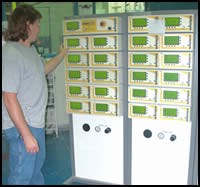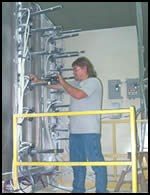New Guns And Controls Boost Transfer Efficiency And Save Powder
At Rubbermaid’s Jackson, MO, plant, they spray quite a bit of powder to coat wire shelving systems for closet organization and other applications.
At Rubbermaid’s Jackson, MO, plant, they spray quite a bit of powder to coat wire shelving systems for closet organization and other applications. How much powder?
“A lot,” says finishing technician Donnie Glueck, sidestepping the question. “And 95% of it is white.” The white stuff—a custom formulation from powder supplier Valspar Corp. arrives at Rubbermaid in 2,000-lb bags, and the plant goes through multiple bags every week.
Glueck says powder coating is unusual in the wire shelf market. “Our main competitors put vinyl on their wire shelves, not powder coat,” he explains. “It’s not as durable, and it has a kind of sticky feel. We like to think powder coat is the preferred finish and gives us a competitive advantage.”
The main reason for the high powder usage is simple: the plant paints tons of wire shelf components every day. And, the nature of the products is responsible for the facility’s relatively low transfer efficiency, which hovers around 20%. “That’s not bad, considering the product is about 90% air,” Glueck says.
Fortunately, the cartridge filter reclaim system on the plant’s main powder booth works well. “With our transfer efficiencies the way they are, we have to be good at reclaim,” Glueck says. “We use a cartridge system to reclaim everything minus what the sieve kicks out, which is minimal.”
Recently, the plant took another step to reduce powder consumption by installing new guns and controls. Supplied by Wagner Industrial Solutions (Carol Stream, IL), the new system has already resulted in a double-digit powder savings.
The Goal
According to manufacturing engineer Tom Sawyer, who’s involved in the plant’s lean manufacturing initiative, the motivation for the upgrade was simple: increase efficiency and reduce costs.
“One of our goals—THE goal, actually—is to reduce costs,” Sawyer explains. “We’re pretty serious about cost reduction issues and productivity improvements. After we decided to upgrade the guns, we got quotes from two different companies and chose the one that looked most attractive. Wagner basically said, ‘Take the guns and try them to 45 days. If you don’t like the results, send them back.’ We had nothing to lose, because if the guns didn’t work out we didn’t need to keep them.”
The new installation includes 34 stationary guns, plus digital controls and software. It replaces 24 guns, 16 of which were reciprocating. “We used the old guns for 12 years,” Glueck says. We figured everything else we do had changed over that time, so why not start looking at this for potential savings?”
Replacing 24 guns with 34 guns may not sound like such a lean thing to do, but it makes perfect sense when explained by value stream manager Scott Seabaugh. “Before, we had reciprocating guns and stationary guns,” he explains. “Basically we were painting a big ‘M’ or ‘W’ as the shelves moved through the booth, then using the stationary guns to create a paint fog to try to cover problem areas such as weld intersections and places where the wire is bent. This system is much more precise. It lets us place our guns where we need them and be more accurate in our spray, and spray a lot less powder.”
The Process
Production at Jackson starts with coils of wire that are straightened, cut to length, and welded to produce shelves and other closet organizer components. The components are hung on custom racks on one of two powder coating lines. Shelves receive a four-stage pretreatment consisting of an alkaline cleaner, rinse, iron phosphate and rinse, then are dried before coating.
The plant powder coats four basic styles of shelving in four widths, for a total of basically 16 possible shelf configurations. Any configuration can run at any time, and the product mix can change from hour to hour. The plant does spray colors other than white, but color changes are not a particular issue—they may happen once a month.
Parts are cured at 450-460°F in a gas-fired oven with an infrared boost. According to Glueck, the IR system was added when the line switched from a powered free conveyor system to a monorail design. “After we brought in the monorail, we could no longer turn racks sideways in the curing oven, so we had to add the IR boost to go straight through,” he explains. Rack burnoff takes place at 800°F in a fluidized bed oven. Rejected shelves and other components are recoated without stripping.
Guns and Controls
According to Wagner Systems, the C3 guns and modular DigiTech control system installed at Jackson provide a high degree of automation and easy operation. The system can save powder by providing more efficient dispersion and automatically compensating for wear on injectors and other components.
Glueck says the digital controls have made a big difference in the plant’s ability to finely control powder application. “The control settings let us go, for example, from 2.1 bars of powder to 2.2 bars,” he explains. “With the old guns, you had a dial indicator that went from 1 to 6, and you just couldn’t make fine adjustments with that.”
The control also stores multiple spray recipes, enabling operators to call up the recipe for a shelf configuration at the touch of a button. “Right now, there are about 55 different recipes stored in the controllers,” Glueck explains. “Recipes include amperage, voltage, feed air, total air, and atomizing air. There’s also a gun position recipe. The operators don’t move guns in and out, but we do change gun angles and nozzles.”
“The recipes let the person on third shift do exactly what first shift is doing,” Seabaugh says. “It’s really helped our shift-to-shift consistency.”
Rubbermaid engineers and managers like the Wagner control software because it allows them to monitor and track any alterations made to spray recipes. “The tracking software is very valuable,” Sawyer says. “Knowledge is power, and one of the main tenets of lean philosophy is that your people what you don’t know.
“With the software, we can look at any time to see what changes were made, not necessarily to check up on the operators but to incorporate their improvements. And, it helps us control variation and get a better handle on what we’re doing.”
The software also allows recipes to be written off-line and then downloaded to the controls at the spray booth. “We’re still working to optimize this system, and we have different spray scenarios we want to try,” Glueck says. “The ability to write a recipe in the office and then try it later is a big plus for us.”
Learning Curve
After testing at Wagner, the system was installed in Jackson near the end of June. According to Glueck, Rubbermaid managers and operators had to overcome some initial hangups to make the spray system work. “The first couple of weeks after installation were probably the most tedious part,” he says. “We had to run a part, take measurements, and tweak the recipe and gun positions a little bit to try to reproduce Wagner’s lab test results.
“There were some growing pains,” Glueck says. “Along about the third week we were ready to go back to our old system. Operators didn’t like it. The system meant change, and change is hard. But we learned, and we managed to get it sorted out, and the system really came around. We’re still learning, and I wouldn’t be surprised if we get another 4-5% savings out of the guns as we continue to learn how to use them over the next five or six months.”
According to Seabaugh, learning how changes in other areas of the powder process impact the new guns is also a challenge. “We changes cartridges two weeks ago, and that changed the air flow in the booth. It introduced some variability in the process, so we’re re-learning a few things. It really is a continual process, and we have to be diligent in tracking and documenting changes and staying on top of it to be as efficient as possible.”
Lean and Six Sigma
As you might have gathered from all the talk about repeatability, reducing variability, tracking and documentation, Rubbermaid is looking to lean and six sigma initiatives to help with ongoing manufacturing cost reductions. And, the new system fits right in with those initiatives, according to Glueck.
“We never officially wrote up a book on the gun project, but we definitely used six-sigma tools in its implementation,” Glueck says. “And we’re continuing to use them.
“One of the big things is, we can document what we do now—gun placements, control settings, and other parameters—and continue to work on improving our repeatability. We can call up recipes and go back to the same settings we used the last time we ran the job.”
Seabaugh gives credit to both Wagner and Valspar for developing and implementing the new system and for continuing to help Rubbermaid get more savings. “Wagner said they could get us powder savings, and they worked with us to do it,” he says. “And people from Valspar are in here now trying to help us get even more savings. They’re working to help us save powder. It’s their powder we’re buying, so we appreciate that and feel we have a very good relationship with them.”
“Basically, the new spray setup changed our painting philosophy,” Glueck concludes. “We are much more consistent and repeatable. We can do things over and over, from shift to shift, whereas before we were guessing.”
Related Content
Hybrid Oven Features Catalytic and Electric Infrared Technology
Source: Trimac Trimac Industrial Systems will be featuring our new innovation, the Pro-Cat oven.
Read More‘Warming Up’ to the Truth about Ovens for Surface Treatment
Understanding the different types of oven heat technology for surface finishing, including how they work, and their advantages and disadvantages, can help determine the best heating solution for an application.
Read MoreThe Lowdown on Infrared Curing
In this Q&A, infrared curing’s ins and outs are covered by Carlisle Fluid Technologies, including how it works, why its a popular curing type and the benefits of it.
Read MoreHeat Up Your Maintenance Plan for Best Oven Performance
Improve efficiency and profitability with a preventive maintenance program for your industrial heating equipment.
Read MoreRead Next
Education Bringing Cleaning to Machining
Debuting new speakers and cleaning technology content during this half-day workshop co-located with IMTS 2024.
Read MoreA ‘Clean’ Agenda Offers Unique Presentations in Chicago
The 2024 Parts Cleaning Conference, co-located with the International Manufacturing Technology Show, includes presentations by several speakers who are new to the conference and topics that have not been covered in past editions of this event.
Read MoreEpisode 45: An Interview with Chandler Mancuso, MacDermid Envio Solutions
Chandler Mancuso, technical director with MacDermid Envio discusses updating your wastewater treatment system and implementing materials recycling solutions to increase efficiencies, control costs and reduce environmental impact.
Read More
























